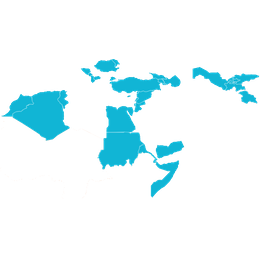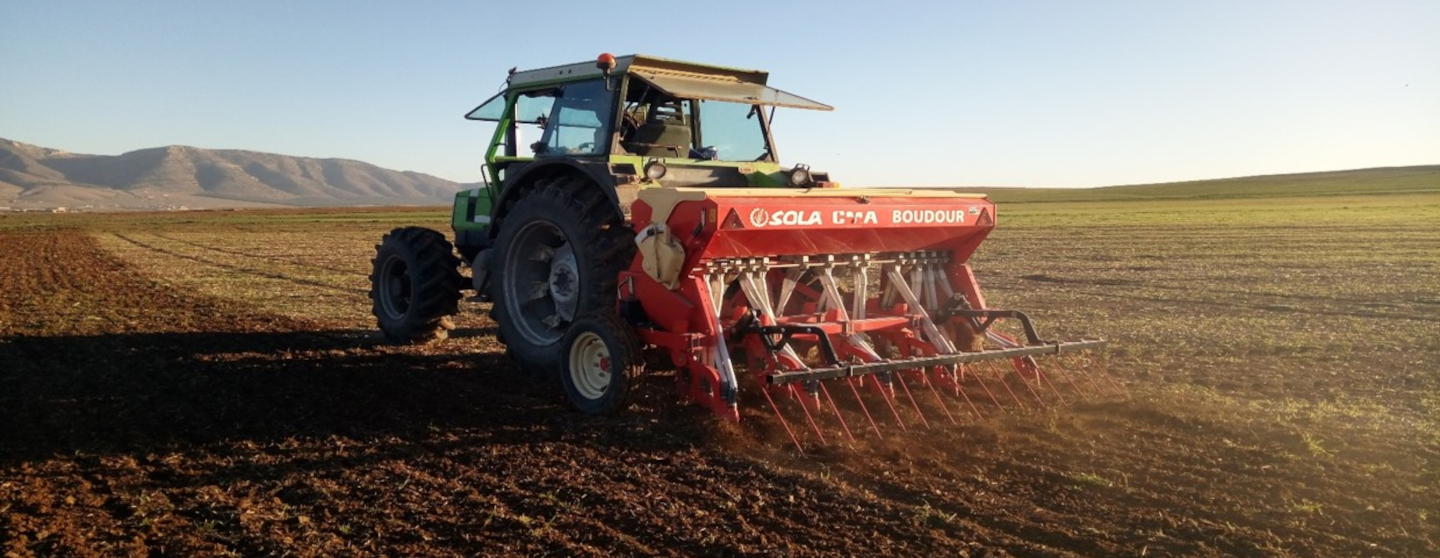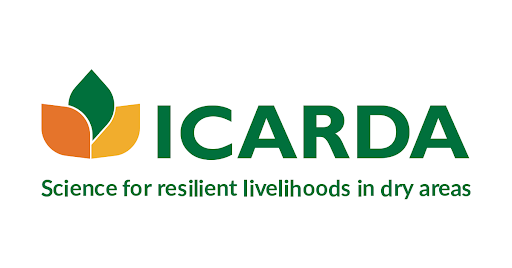Conservation Agriculture
“Since adopting conservation agriculture, we have saved 30 per cent in fuel and labour.”
Nabil Sahli, Treasurer of Société Mutuelle de Services Agricoles, as the association is named.BACKGROUND
Soil damaged by erratic environmental conditions and population growth inhibits productivity, reduces farmers’ incomes and threatens food security. The increasing frequency of droughts and extreme weather events due to climate change is challenging conventional agriculture and further affecting crop production and biomass. Conservation agriculture is a solution that addresses these challenges while making crop production more resilient to climate change.
WHAT’S INVOLVED
Training with farmers: on conservation agriculture learn smart agronomic practices to diversify their cropping systems, save energy and labour and stabilize yields under dryland conditions.
Local farmer-designed technology: Locally produced, low-cost, zero-tillage seeders use locally available parts and mechanical skills, creating local jobs by expanding the market for repairs and technical services.
EXPLORE THIS SOLUTION
Conservation agriculture can offer:
- A sustainable agricultural practice that increases livelihoods while tackling negative effects of climate change
- Training modules to accompany the solution that teach farmers how to implement smart agricultural practices

Countries involved
Bolivia, Nicaragua, Algeria, Mexico, Jordan, Tunisia
Project partners
International Fund for Agricultural Development, National Agricultural Research Extension Systems, Local public and private agricultural machines manufacturers , Farmers organizations, Research Program on Wheat, International Maize and Wheat improvement Center
Project dates
2013 - Ongoing
Share this solution
Bookmark this solution
BookmarkShow Full Solution
Summary
When properly managed, conservation agriculture can benefit both farmers and the environment. Conservation agriculture refers to the use of technologies and practices that enhance crop productivity while improving resource-use efficiency and soil health. As an alternative to conventional tillage for rainfed drylands, it not only saves time and labour, but also conserves water and nutrients in the soil to make crop production more resilient to climate change.
Challenge/Problem
Climate change, erratic environmental conditions and population growth put pressure on agricultural systems. As a result of overexploitation to meet demand, soils are impoverished, which reduces productivity. This is particularly true in low- and middle-income countries in North Africa and Latin America and the Caribbean, where rural people are highly vulnerable to unpredictable and variable rainfall. The increased frequency of droughts and extreme weather events, as well as changing food demands and preferences, further impact crop production and degrade biomass. Conservation agriculture can address these challenges. Used by a majority of farmers in Australia and Brazil, and by many in North America and other middle- and high-income countries, the solution has the potential to improve food security and preserve natural resources in dryland agro-ecosystems in Central and West Asia, the Middle East, and in North and sub-Saharan Africa.
Solution
Using conservation agriculture, farmers forego ploughing their farmlands and instead between harvests grow legume-based forages and crops, whose residue they leave in the field. This practice balances yields, improves soil fertility, increases efficiency and conserves water and resources. Conservation agriculture enables smallholder land users to optimize yields while reducing production costs and improving soil health.
To accompany conservation agriculture, ICARDA has developed a locally produced low-cost, zero-tillage seeder. This complementary innovation adds value as it helps reduce fuel, labour and machinery costs and conserves soil moisture. It helps conservation agriculture achieve its main aim of minimizing soil disturbance. The innovation uses local inputs and mechanical skills, creating local jobs by expanding the market for repairs and technical services. The seeders were tested and promoted in collaboration with national partners and lead farmers.
Technical support for this IFAD-funded solution is provided by national agricultural research and extension systems. Conservation agriculture has also received government support. The Use of Conservation Agriculture in Crop-Livestock Systems (CLCA), a two-phase project funded by IFAD, includes local manufacturing of zero-till seeders.
Farmers who have adopted conservation agriculture have expressed appreciation for the reduction in work and the cost of labour and fuel. Adnen Abdrabbou, the first farmer to pioneer conservation agriculture in Tunisia, opened up his farm for on-site trials involving the International Center for Agricultural Research in the Dry Areas (ICARDA) and three national agricultural institutes: l’Institut National de Recherche Agronomique de Tunis, l’Institut National des Grandes Cultures, and l’Ecole Supérieure d'Agriculture du Kef. One of the trials has lasted two decades, making it Tunisia’s most well-known on-farm trial of conservation agriculture.
“As farmers, we borrow the land for a short time, and we are responsible for taking care of it until we hand it over to our children and their children,” he said.
Results
In addition to income diversification, conservation agriculture has resulted in the following results:
- Zero-tillage seeder: Compared to imported machines, the seeders designed by local farmers produce similar yields but feature more sowing adjustability and a higher germination rate.
- Increased yields: In Jordan, where wheat production is often constrained by prolonged drought, farmers in Irbid experienced average wheat yields that were 16 per cent higher than those achieved under conventional practices, generating net returns of US$296 per hectare.
- Government support: After trials demonstrated a 19 per cent increase in wheat yields, Moroccan policymakers are including conservation agriculture in a national effort to reverse falling agricultural productivity and to stabilize yields.
- Local job creation: The farmer-designed technology associated with conservation agriculture uses locally available parts and mechanical skills, creating jobs by expanding the market for repairs and technical services.
- Trainings: Nearly 1,200 women farmers and 600 young farmers were reached in Latin America and the Near East and North Africa region.
- Cost-effective: Conservation agriculture reduces inputs and workloads for farmers.
Lessons Learned/Potential for replication
Production systems and socio-cultural contexts can vary widely within a region. This can be an incentive for interregional knowledge exchange and integrated capacity development of conservation agriculture for farmers, especially women and young people.
Innovative agricultural development approaches are needed to inform and demonstrate to farmers the benefits of conservation agriculture. This can be achieved through activities such as:
- Intensive guidance for farmers on how to change centuries-old conventional farming methods.
- On-the-job training and creation of ‘conservation agriculture services’ for farmers in areas such as planting and weed control.
- Subsidizing machinery for conservation agriculture in order to support the transition from conventional practices.
Next Steps
Conservation agriculture reduces greenhouse gas emissions, improves air quality by removing the need to burn crop residues, and is environmentally friendly in that it reduces the use of fertilizers, pesticides and herbicides. Going forward, there are opportunities in a range of sectors to move toward adopting conservation agriculture. Through the involvement of National Agricultural Research Extension Service and links with IFAD investment projects, the benefits are expected to reach farmers on a global level.
Solution Document Downloads
Solution Additional Resources
ICARDALast update: 25/05/2021



